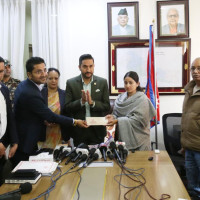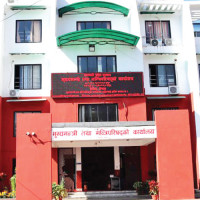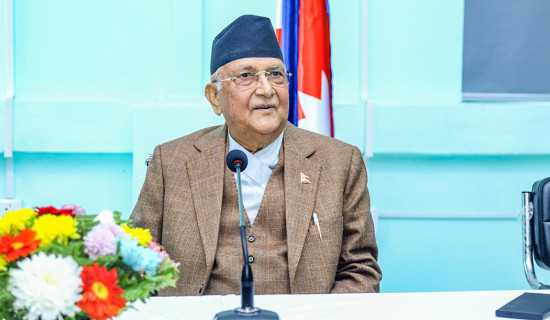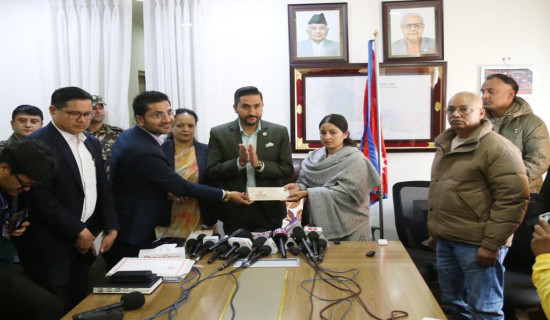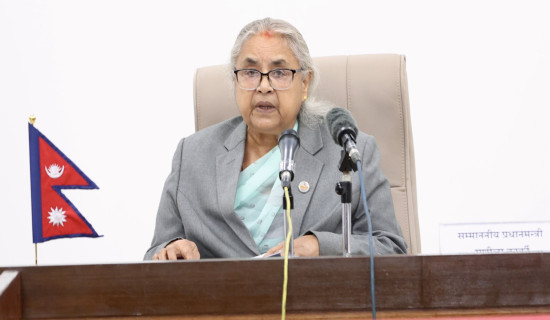- Tuesday, 18 November 2025
NDRRMA says 50 districts to be affected from cold wave, snowfall this year
Kathmandu, Nov 18: The government has prepared a separate draft of the National Action Plan-2083 to reduce possible risk from snowfall and cold wave in mountain and high-hilly areas as well as in the Tarai-Madhes region during winter.
The National Disaster Risk Reduction and Management Authority (NDRRMA) has given final touches to the draft after holding consultation and discussions with bodies concerned.
Earlier, Home Minister Om Prakash Aryal had directed the Authority to carry out activities for preparedness to reduce possible risk from snowfall and cold wave.
NDRRMA Chief Executive Officer Dinesh Prasad Bhatt, said preparation was underway to pass the action plan from the executive committee chaired by the Home Minister and to implement it.
It has been estimated that 29 mountain and high-hilly districts might be affected from snowfall and 21 districts in Tarai from cold wave.
Special strategy activities have been included in the action plan to adopt special precautions and reduce possible risk from snowfall and cold wave in these districts. The government is to issue the national action plan for the first time with an objective of lessening possible losses and impact on lives from snowfall and cold wave.
According to the NDRRMA, in general, there is impact of heavy snowfall in mountain and high-hilly districts as well as of the cold wave in Tarai districts from mid-November to mid-March.
Similarly, Jhapa, Sunsari, Morang, Saptari, Siraha, Dhanusha, Mahottari, Sarlahi, Rautahat, Bara, Parsa, Nawalparasi (Bardaghat Susta East), Nawalparasi (Bardaghat Susta West), Rupandehi, Kapilvastu, Dang, Banke, Bardiya, Kailali and Kanchanpur would be most affected from cold wave.
It is estimated that the cold wave will have general impact also in Udayapur, Makawanpur, Sindhuli and Surkhet.
According to the action plan, it is predicted that the mountainous and high hill districts of Koshi, Bagmati, Gandaki, Lumbini, Karnali and Sudurpaschim provinces will be most affected by snowfall.
It is estimated that the upper reaches of Taplejung, Sankhuwasabha, Okhaldhunga, Solukhumbu, Panchthar, Tehrathum, and Bhojpur in Koshi province will be more affected.
The action plan states that snowfall will affect Dolakha, Ramechhap, Sindhupalchok, Rasuwa and Dhading in Bagmati Province, and Gorkha, Manang, Mustang, Baglung and Kaski in Gandaki province, and Rukum East in Lumbini province.
Dolpa, Jumla, Mugu, Humla and Kalikot in Karnali province and Bajura, Bajhang, Darchula, Baitadi and Dadeldhura in Sudurpaschim province are highly likely to be more affected by snowfall.
Executive Chief Bhatt stated that the implementation of the programme would help make life easier for the underprivileged people, senior citizens, children, people with chronic illnesses, pregnant women, new mothers, and persons with disabilities during the winter.
A plan has been prepared to minimize the potential impact of snowfall and cold waves on people's lives and to make advance arrangements for the necessary relief materials for response.
“Based on this same plan, all districts, provinces and local levels affected by snowfall will be able to prepare and implement action plans according to local conditions,” said Executive Chief Bhatt.
A strategy has been formulated to identify, by December 1, the areas and target groups that may be affected by snowfall, update the data, and determine the priorities of beneficiaries in accordance with the work plan.
The action plan includes the strategy for preparations for disaster response due to snowfall, measures to reduce damage based on forecasts, and making the forecasting and early warning mechanisms operational to ensure timely information reaches the concerned communities throughout the month of Mangsir.(RSS)





